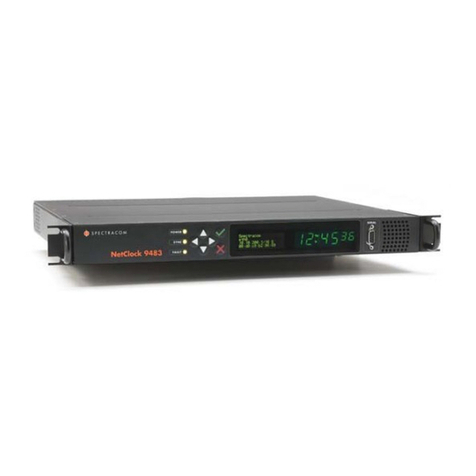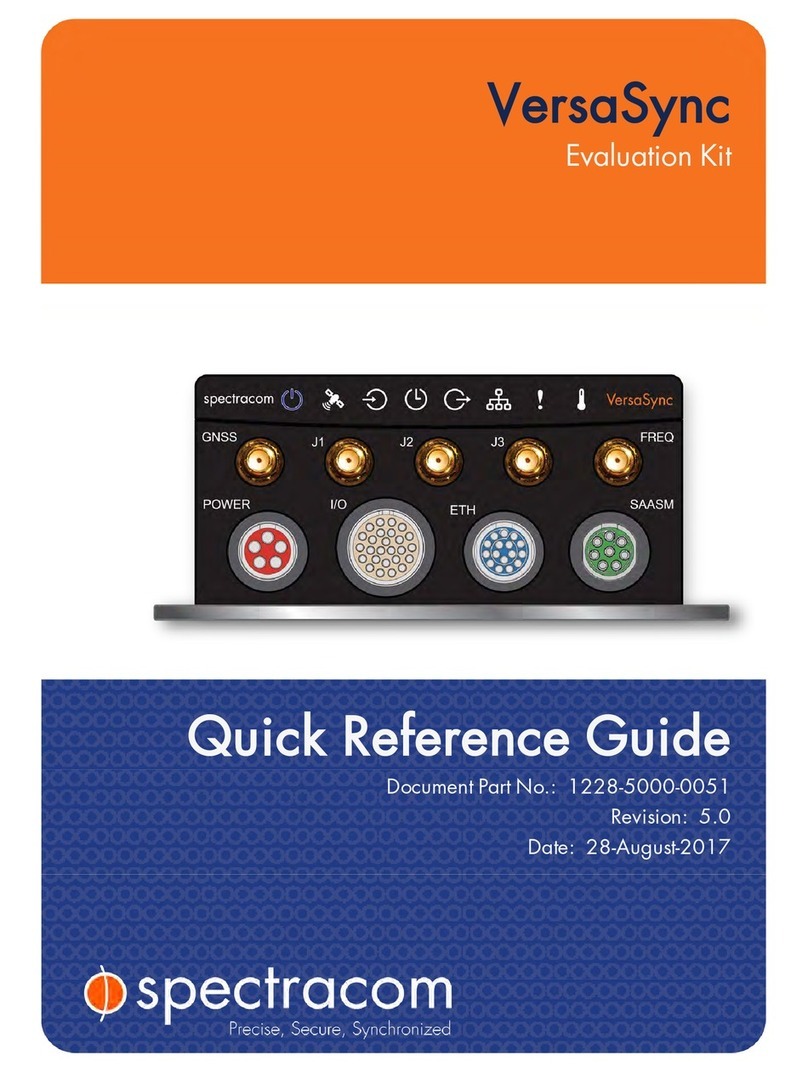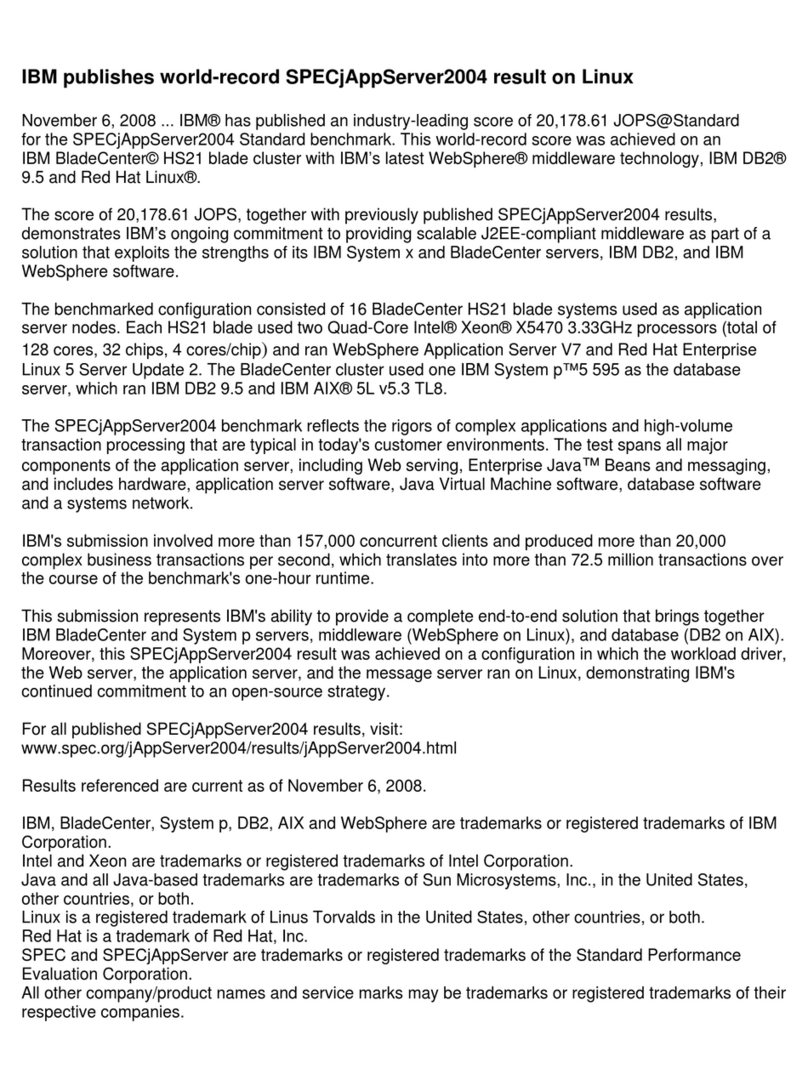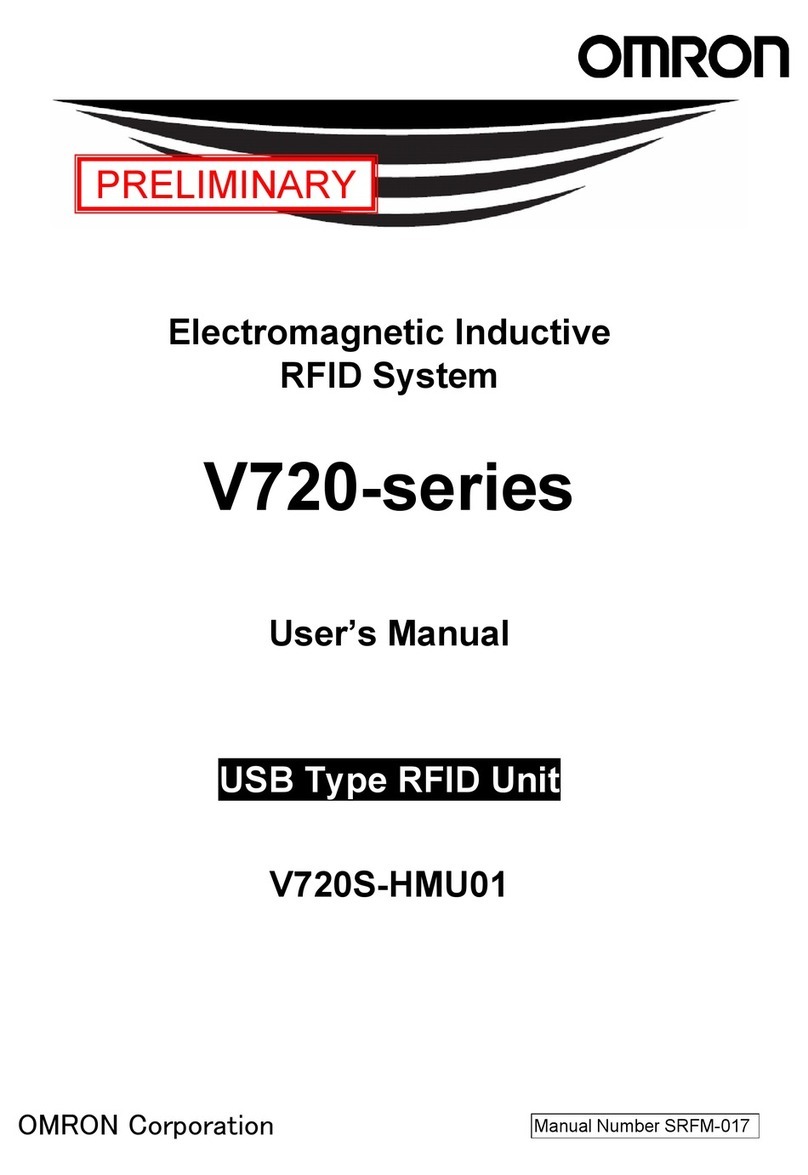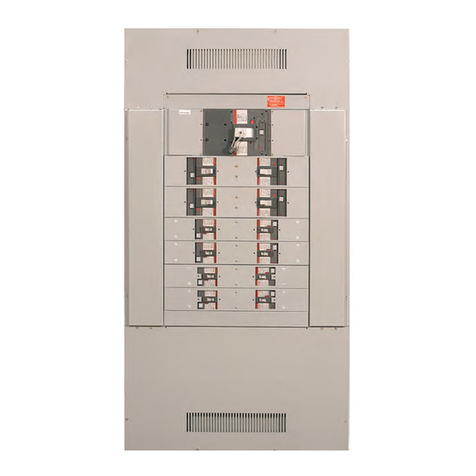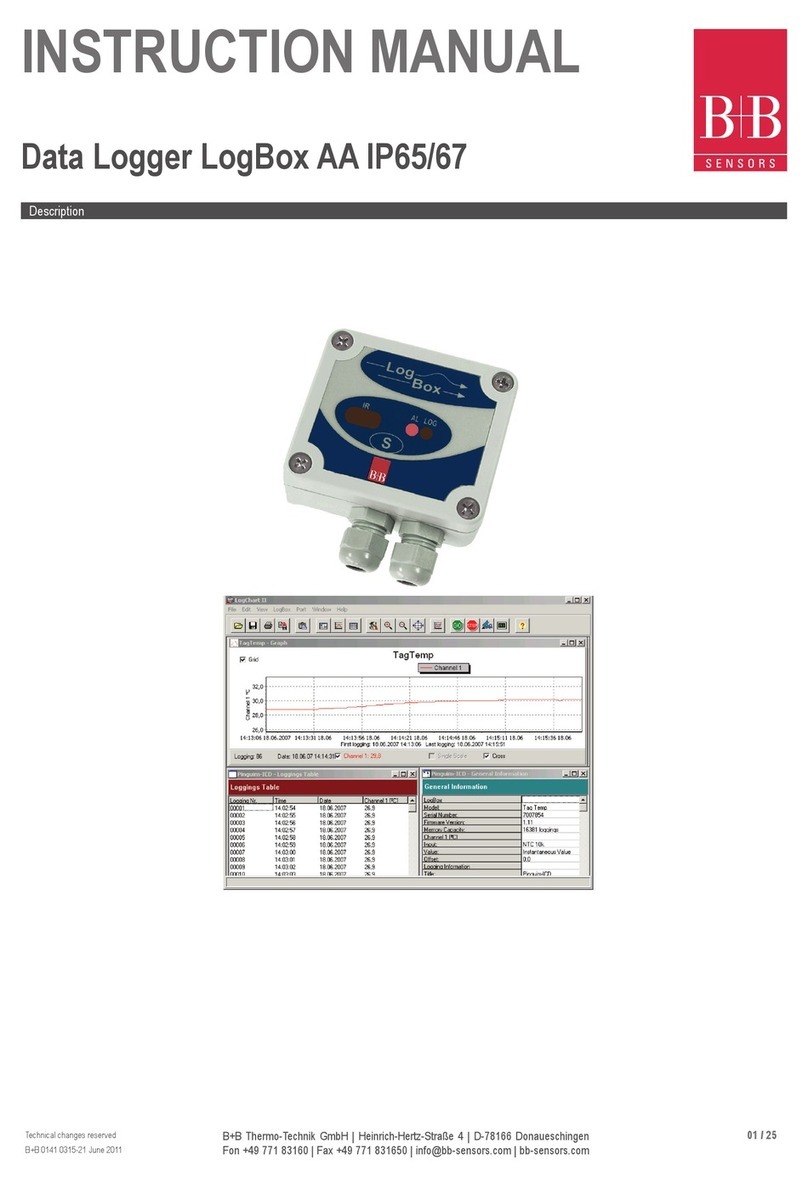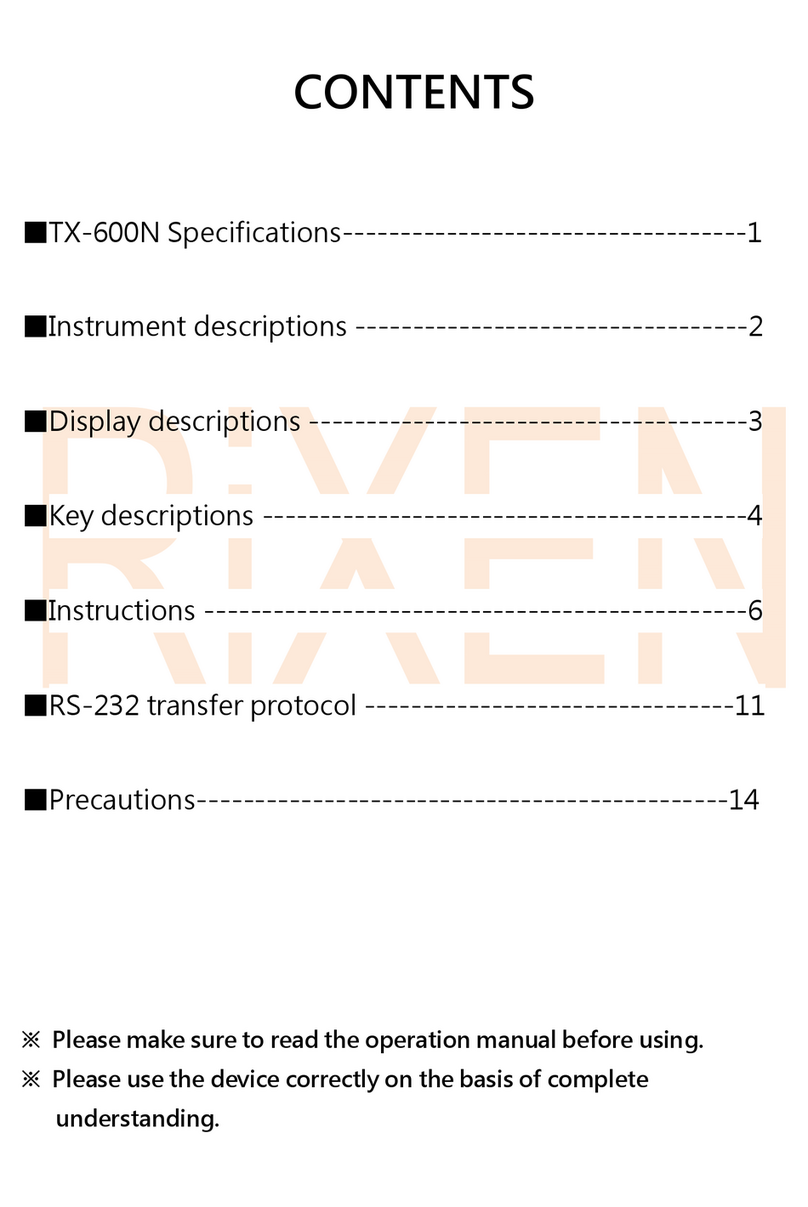Spectracom VelaSync 1232 User manual


© 2018 Spectracom. All rights reserved.
The information in this document has been carefully reviewed and is
believed to be accurate and up-to-date. Spectracom assumes no respons-
ibility for any errors or omissions that may be contained in this document,
and makes no commitment to keep current the information in this manual,
or to notify any person or organization of updates. This User Manual is sub-
ject to change without notice. For the most current version of this doc-
umentation, please see our web site at spectracom.com.
Spectracom reserves the right to make changes to the product described in
this document at any time and without notice. Any software that may be
provided with the product described in this document is furnished under a
license agreement or nondisclosure agreement. The software may be used
or copied only in accordance with the terms of those agreements.
No part of this publication may be reproduced, stored in a retrieval system,
or transmitted in any form or any means electronic or mechanical, including
photocopying and recording for any purpose other than the purchaser's
personal use without the written permission of Spectracom.
Other products and companies referred to herein are trademarks or
registered trademarks of their respective companies or mark holders.
Orolia USA, Inc. dba Spectracom
• 1565 Jefferson Road, Suite 460, Rochester, NY 14623 USA
• 3, Avenue du Canada, 91974 Les Ulis Cedex, France
Do you have questions or comments regarding this User Manual?
è E-mail: techpubs@spectracom.com
Warranty Information
For a copy of Spectracom's Limited Warranty policy, see the Spectracom
website: http://spectracom.com/support/warranty-information.
VelaSync User's Manual I

Blank page.
II VelaSync User's Manual

CONTENTS
VelaSync User's Manual • TABLE OF CONTENTS III
CHAPTER 1
Introduction & Overview 1
1.1 Product Overview 2
1.2 About this Manual 2
1.3 Designated Use of this Product 4
1.4 Technical Specifications 5
1.4.1 Hardware 5
1.4.1.1 Server 5
1.4.1.2 GPS/GNSS Receiver 5
1.4.1.3 Oscillator 6
1.4.2 I/O Connectors 6
1.4.2.1 Timing Connector 6
1.4.2.2 Communication Ports 9
1.4.3 Environmental Specifications 9
1.4.4 Size, Weight & Power 9
1.5 Front Panel Overview 10
1.5.1 Control Buttons 10
1.5.2 Control Panel LEDs 10
1.5.3 Hard Disk Drives 11
1.6 Rear Panel Overview 12
1.7 The VelaSync Web UI 13
1.7.1 The Web UI HOME Screen 13
1.7.2 The INTERFACES Menu 14
1.7.3 The Configuration MANAGEMENT Menu 15
1.7.4 The TOOLS Menu 15
1.8 YOUR SAFETY 17
1.8.1 SAFETY: Symbols Used 17
1.8.2 SAFETY Advisories 18
1.9 Regulatory Compliance 20

CHAPTER 2
Installation & Setup 23
2.1 Unpacking and Inventory 24
2.2 Selecting the Right Installation Location 24
2.3 Rack Mounting: SAFETY 25
2.4 Rack Installation 26
2.4.1 TELCO Rack Installation 28
2.5 Basic Connections Setup 29
2.5.1 Connecting the GPS Antenna 29
2.5.2 Connecting Power 29
2.5.3 Establishing a Network Connection 30
2.6 Accessing the WebUI 31
2.7 Configuring IP Address(es) 32
2.7.1 Changing the IP address using an Ethernet connection 32
2.7.2 Setting Up an IP Address via the Serial Port 33
2.7.3 Subnet Mask Values 35
2.8 Advanced Timing Connections 35
2.8.1 TSync I/O Signals 35
2.8.1.1 Timing Interface Adapter Cable 36
2.8.1.2 Basic Breakout Cable 37
2.8.1.3 Premium Breakout Cable 39
2.8.2 Status LEDs 42
2.9 Configuring Network Settings 43
2.9.1 General Network Settings 45
2.9.2 Network Ports 46
2.9.3 Network Services 48
2.9.4 Access Rules 48
2.9.5 IPMI Configuration 50
2.9.6 SSH 50
2.9.7 SNMP 57
2.9.7.1 SNMP V1/V2c 61
2.9.7.2 SNMP V3 63
2.9.7.3 SNMP Traps 65
2.9.8 VLAN Support 67
2.10 Configuring NTP 68
IV VelaSync User's Manual • TABLE OF CONTENTS

2.10.1 Checklist NTP Configuration 69
2.10.2 The NTP Setup Screen 69
2.10.3 Dis-/Enabling NTP 72
2.10.4 Viewing NTP Clients 72
2.10.5 Restoring the Default NTP Configuration 73
2.10.6 NTP Output Timescale 73
2.10.7 NTP Reference Configuration 75
2.10.8 NTP Servers and Peers 75
2.10.8.1 The NTP Servers and NTP Peers Panels 76
2.10.8.2 NTP Servers: Adding, Configuring, Removing 77
2.10.8.3 NTP Peers: Adding, Configuring, Removing 79
2.10.9 NTP Authentication 81
2.10.9.1 NTP: Symmetric Keys (MD5) 81
2.10.10 NTP Access Restrictions 84
2.10.11 Spectracom Technical Support for NTP 86
2.11 Configuring PTP 86
2.11.1 The PTP Screen 87
2.11.1.1 The PTP Settings Panel 87
2.11.1.2 The PTP Statistics Panel 90
2.11.2 Enabling/Disabling PTP 90
2.11.3 Configuration — General Steps 91
CHAPTER 3
Managing Time 93
3.1 The Time Management Screen 94
3.2 System Time 95
3.2.1 System Time 96
3.2.1.1 Configuring the System Time 96
3.2.1.2 Timescales 97
3.2.1.3 Manually Setting the Time 99
3.2.1.4 Using Battery Backed Time on Startup 101
3.2.2 Timescale Offset(s) 103
3.2.2.1 Configuring a Timescale Offset 103
3.2.3 Leap Seconds 104
3.2.3.1 Reasons for a Leap Second Correction 104
3.2.3.2 Leap Second Alert Notification 105
VelaSync User's Manual • TABLE OF CONTENTS V

3.2.3.3 Leap Second Correction Sequence 105
3.2.3.4 Configuring a Leap Second 106
3.2.4 Local Clock(s), DST 107
3.2.4.1 Adding a Local Clock 107
3.2.4.2 DST Examples 109
3.2.4.3 DST and UTC, GMT 110
3.3 Managing References 111
3.3.1 Input Reference Priorities 111
3.3.1.1 Configuring Input Reference Priorities 112
3.3.1.2 The "Local System" Reference 115
3.3.1.3 The "User/User" Reference 116
3.3.1.4 Reference Priorities: EXAMPLES 118
3.3.2 Reference Qualification and Validation 122
3.3.2.1 Reference Monitoring: Phase 122
3.3.3 The GNSS Reference 123
3.3.3.1 Reviewing the GNSS Reference Status 124
3.3.3.2 Determining Your GNSS Receiver Model 128
3.3.3.3 Selecting a GNSS Receiver Mode 129
3.3.3.4 Setting GNSS Receiver Dynamics 132
3.3.3.5 Performing a GNSS Receiver Survey 133
3.3.3.6 GNSS Receiver Offset 134
3.3.3.7 Resetting the GNSS Receiver 135
3.3.3.8 Deleting the GNSS Receiver Position 136
3.3.3.9 Manually Setting the GNSS Position 138
3.3.3.10 GNSS Constellations 140
3.3.3.11 A-GPS 143
3.3.4 Holdover Mode 148
3.4 Managing the Oscillator 152
3.4.1 Configuring the Oscillator 153
3.4.1.1 Time Figure of Merit (TFOM) 155
3.4.2 Monitoring the Oscillator 156
3.4.3 Oscillator Logs 159
CHAPTER 4
System Administration 161
4.1 Issuing the HALT Command Before Removing Power 162
4.2 Rebooting the System 163
VI VelaSync User's Manual • TABLE OF CONTENTS

4.3 Hardware Tasks 163
4.3.1 Replacing a Power Supply 163
4.3.2 Removing/Installing a Hard Disk Drive 164
4.4 Notifications 166
4.4.1 Configuring Notifications 167
4.4.2 Notification Event Types 169
4.4.2.1 Timing Tab: Events 169
4.4.2.2 GPS Tab: Events 170
4.4.2.3 System Tab: Events 170
4.4.3 Configuring GPS Notification Alarm Thresholds 170
4.4.4 Setting Up SNMP Notifications 172
4.4.5 Setting Up Email Notifications 172
4.5 Managing Users and Security 175
4.5.1 Managing User Accounts 175
4.5.1.1 Types of Accounts 175
4.5.1.2 About "user" Account Permissions 175
4.5.1.3 Rules for Usernames 177
4.5.1.4 Adding/Deleting/Changing User Accounts 177
4.5.2 Managing Passwords 180
4.5.2.1 Configuring Password Policies 180
4.5.2.2 The Administrator Password 181
4.5.2.3 Lost Password 182
4.5.3 Web UI Timeout 184
4.6 Miscellanous Typical Configuration Tasks 184
4.6.1 REST API Configuration 184
4.6.2 Creating a Login Banner 185
4.6.3 Show Clock 186
4.6.4 Synchronizing Network PCs 187
4.7 Quality Management 187
4.7.1 System Monitoring 187
4.7.1.1 Status Monitoring via the Web UI 187
4.7.1.2 Ethernet Monitoring 190
4.7.1.3 NTP Status Monitoring 191
4.7.1.4 Monitoring the Oscillator 192
4.7.2 Logs 195
4.7.2.1 Types of Logs 195
VelaSync User's Manual • TABLE OF CONTENTS VII

4.7.2.2 The Logs Screen 200
4.7.2.3 Displaying Individual Logs 200
4.7.2.4 Saving and Downloading Logs 201
4.7.2.5 Setting up a Remote Log Server 202
4.7.2.6 Clearing All Logs 204
4.8 Updates and Licenses 204
4.8.1 Software Updates 204
APPENDIX
Appendix 207
5.1 Troubleshooting 208
5.1.1 Minor and Major Alarms 208
5.1.2 Troubleshooting: System Configuration 209
5.1.2.1 System Troubleshooting: Browser Support 209
5.1.3 Troubleshooting – Unable to Open Web UI 209
5.1.4 Troubleshooting via Web UI Status Page 210
5.1.5 Troubleshooting GNSS Reception 212
5.1.6 Troubleshooting Hardware Issues 213
5.1.6.1 Power Supply Failure 213
5.1.7 Troubleshooting – 1PPS, 10 MHz Outputs 214
5.1.8 Troubleshooting – Network PCs Cannot Sync 214
5.1.9 Troubleshooting Software Update 215
5.2 Command-Line Interface 216
5.2.1 Setting up a Terminal Emulator 216
5.2.2 CLICommands 217
5.3 IRIG Standards and Specifications 221
5.3.1 About the IRIG Output Resolution 221
5.3.2 IRIG Carrier Frequencies 222
5.3.3 IRIG B Output 226
5.3.4 IRIG E Output 230
5.3.5 IRIG Output Accuracy Specifications 234
5.4 Choosing a GNSS Antenna Location 235
5.5 Maintenance and Service 237
5.6 Product Registration 237
5.7 Links to External Information 238
VIII VelaSync User's Manual • TABLE OF CONTENTS

BLANK PAGE.
XVelaSync User's Manual • TABLE OF CONTENTS

CHAPTER 1•VelaSync User's Manual 1
CHAPTER 1
Introduction & Overview
The following topics are included in this Chapter:
1.1 Product Overview 2
1.2 About this Manual 2
1.3 Designated Use of this Product 4
1.4 Technical Specifications 5
1.5 Front Panel Overview 10
1.6 Rear Panel Overview 12
1.7 The VelaSync Web UI 13
1.8 YOUR SAFETY 17
1.9 Regulatory Compliance 20

1.1 Product Overview
VelaSync® 1232 High-Speed Time Server is an enterprise-class time serving appliance
designed for high-frequency trading and other network applications that require low
latencies.
VelaSync’s customized configuration, comprising state- of- the- art network syn-
chronization software, precision GNSS (GPS) timing technology, and reliable server hard-
ware allows it to provide high-performance time management over multiple network
interfaces.
VelaSync 1232 (part number 1232-xxxx-xxxx) is the latest version of this unit. For
the user manual for an original VelaSync 1225 (part number 1225-xxxx-xxxx) see
the VelaSync User's Manual, archived on the Spectacom website.
Hardware
The customized Supermicro® server platform is a 1U server comprised of a standard
chassis and motherboard, as well as a GNSSreceiver plus oscillator (OCXO, or Rubid-
ium), two hard disks (RAID), two power supplies, and several time, frequency, and com-
munication ports.
Software
The pre-installed Spectracom time synchronization and management software allows
to distribute very accurate time throughout a network, supporting NTP and PTP pro-
tocols. In day-to-day operation, the software allows system administrators to centrally
monitor time synchronization accuracy throughout the network in an efficient manner.
Figure 1-1: VelaSync High Speed Time Server
1.2 About this Manual
This User Manual for the VelaSync High-Speed Enterprise Time Server provides you
with:
descriptions of features and functions, as well as
installation and configuration guidance
instructions for specific tasks related to using this product
2CHAPTER 1•VelaSync User's Manual Rev. 3
1.1 Product Overview

safety-related information
technical specifications
other reference information.
The main objectives of this User Manual are:
a. to assist you with the installation and configuration of this product in a safe and
efficient manner
b. to help you familiarize yourself with VelaSync’s user interfaces, features and func-
tionality.
This User Manual is written for a professional audience, targeting experienced system
integrators and PC technicians.
Other relevant documentation
Note: VelaSync 1232, is the latest version of this unit. For the user
manual for an original VelaSync 1225, see the VelaSync User's Manual,
part number 1225-5000-0050, archived on the Spectacom website.
This Spectracom User Manual is complemented by the Spectracom VelaSync Quick
Reference Guide (PN: 1232-5000-0051), a printed copy of which is shipped with the
unit, and the user documentation for the Supermicro™ SuperO® SuperServer 5018R-
WR, which can be found under:
https://www.supermicro.com/manuals/superserver/1U/MNL-1771.pdf
Manual Organization
This User Manual is organized as follows:
CHAPTER 1: Introduction and Overview
This chapter describes the main features of VelaSync, its hardware operating elements,
and status indicators. Furthermore, the introductory chapter also includes VelaSync's
technical specifications, and regulatory information.
CHAPTER 2: Installation
This chapter describes the preparatory measures, as well as the actual steps necessary
to install VelaSync in a server rack. Also included are SAFETY notes, and typical con-
figuration steps required prior to, or after initial powering on the system.
1.2 About this Manual
CHAPTER 1•VelaSync User's Manual Rev. 3 3

CHAPTER 3: Managing Time
The software running on VelaSync not only serves time during normal operation, but
also represents the main user interface for configuring and monitoring VelaSync.
CHAPTER3 guides you through the web user interface, WebUI, explaining its features
and functions.
CHAPTER 4: System Administration
Frequently executed tasks are described in CHAPTER4, broken down into the cat-
egories, including, "Hardware Tasks" on page163 , "Notifications" on page166 , and
"Managing Users and Security" on page175.
APPENDIX
The document appendix includes "Troubleshooting" on page208, as well as admin-
istrative information, how to contact Spectracom Support, and license notices.
1.3 Designated Use of this Product
This product has been designed and built in accordance with state-of-the-art standards
and the recognized safety rules. Nevertheless, its use may constitute a risk to the oper-
ator or installation/maintenance personnel if used under conditions that must be
deemed unsafe, or for purposes other than the product's designated use.
The VelaSync High-Speed Enterprise Time Server is intended for use in restricted
access areas. A restricted access area can be accessed only through the use of a special
tool, lock and key, or other means of security.
Installation and maintenance of this device should be performed by experienced tech-
nicians only.
For additional information on how and where to use this product, see also "Selecting
the Right Installation Location" on page24 and "YOUR SAFETY" on page17.
4CHAPTER 1•VelaSync User's Manual Rev. 3
1.3 Designated Use of this Product

1.4 Technical Specifications
1.4.1 Hardware
1.4.1.1 Server
Supermicro SuperServer 5018R- WR rackmount server with 1U chassis and
X10SRW-F motherboard:
Four 8cm counter-rotating PWM fans
One passive CPU heatsink
Two riser cards
Four hot-swap 3.5" drive bays (SATA)
Intel 1.8 GHz Quad-Core Xeon Processor
8 GB RAM
Two Western Digital Re 1 TB Enterprise-Class Hard Drives in RAID Mirroring con-
figuration
Two redundant, hot-swap power supplies, 100-240 VAC auto-switch, 50-60 Hz,
500W each, with IEC60320 C14 inlet coupler
Connectivity:
I/O connectors: See "Rear Panel Overview" on page12.
1.4.1.2 GPS/GNSS Receiver
Connector: SMA, +5V to power active antenna (SMA-to-Type-N-adapter cable
included)
Frequency: GNSS L1 (1575.42 MHz)
Satellite tracking: 1 to 50, T-RAIM satellite error management
Synchronization time:
Cold start < 15 minutes (includes almanac download)
Warm start < 5 minutes (assumes current almanac downloaded)
GNSS Antenna system: See antenna installation guide (antenna sold separately)
1.4 Technical Specifications
CHAPTER 1•VelaSync User's Manual Rev. 3 5

1.4.1.3 Oscillator
Table 1-1: Oscillator accuracies
OCXO Rb
Accuracy to UTC (1 sigma locked to
GPS)
50 ns 25 ns
Holdover Accuracy (loss of GPS signal after 2 weeks locked, constant temperature)
After 4 hours 1μs 0.2 μs
After 24 hours 25 μs 1μs
Notes:
• Accuracy to UTC is measured by comparing the internal 1PPS with the GPS ontime point.
• When ordering a VelaSync unit, either an OCXO or Rubidium oscillator must be specified.
• The specifications are subject to a steady environment temperature.
1.4.2 I/O Connectors
1.4.2.1 Timing Connector
The pre-installed TSync-model 25-pin Micro D-Sub Connector, when combined with the
adaptor cable and breakout cable (both included), provides the following I/O options:
Inputs:
1 PPS Input
1 Hz pulse, rising edge or falling edge active (selectable); 100 ns minimum
pulse width
Amplitude: 0V to +5.5V input range, +0.8VVIL, +2.0VVIH
Input impedance: <150 pF capacitive
IRIG AM Input
Accepts IRIG formats A, B, G; NASA36; IEEE 1344
Amplitude: 500mVp-p to 10Vp-p
Modulation ratio: 2:1minimum, 6:1maximum
Input impedance: 10 kΩ minimum
DC Common Mode Voltage: ±150VDC maximum
Input Stability: Better than 100 ppm
6CHAPTER 1•VelaSync User's Manual Rev. 3
1.4 Technical Specifications

IRIG DCLS Input
Accepts IRIG formats A, B, G; NASA36; IEEE 1344 pulse width codes (does
not accept Manchester modulated codes)
RS-485 differential input: –7V to +12V common mode voltage input range,
200mVp-p differential voltage threshold
Single-ended input:
+1.3V VIL min, +2V VIH max
+1.45V VIL typ, +1.85V VIH typ
GPIO Inputs
Amplitude: 0V to +5.5V input range, +0.8VVIL, +2.0VVIH
Polarity (selectable): Positive or negative
Input impedance: <150pF capacitive
50ns active pulse width minimum; 50ns minimum between pulses
Repetition rate. More than 10,000 events per second
Resolution: 5 ns
Outputs
1 PPS Outputs
1Hz pulse, rising edge or falling edge active (selectable)
40 ns to 900 ms active pulse width (selectable, 200 ms default)
Rise time: <10 ns
Signal level: TTL compatible, 4.3Vmin, base-to-peak into 50Ω
[PCIe only: TTL compatible, 2.2 V minimum, base-to-peak into high imped-
ance]
Accuracy: Positive edge within ±[X] nanoseconds of UTC when locked to a
valid 1PPS input reference (for [X], see table below).
Table 1-2: 1 PPS output accuracy
TCXO OCXO
OCXO (Rugged
Option, cPCI & VPX
only)
Accuracy to UTC (1-
sigma locked to GPS)
±50
ns
±50
ns
±25 ns
1.4 Technical Specifications
CHAPTER 1•VelaSync User's Manual Rev. 3 7

TCXO OCXO
OCXO (Rugged
Option, cPCI & VPX
only)
Holdover (constant temp after 2 weeks of GNSS lock)
After 4 hours 12 μs 3 μs 1 μs
After 24 hours 450
μs
100 μs 25 μs
10 MHz Output
10 MHz sine wave output from oscillator
Output impedance: 50 Ω nominal
Output load: 50 Ω minimum
Output harmonics: < -40 dBc
Output spurious: < -70 dBc
IRIG AM Output
Output formats A, B, E (100Hz, 1kHz), G; NASA36; IEEE 1344
Amplitude:
0.5Vp-p to 6Vp-p into 50 Ω, user settable
1Vp-p to 12Vp-p into > 600 Ω
Output impedance: 50 Ω nominal
Output load: 50 Ω minimum
Modulation ratio: 3:1 nominal
Accuracy: ±2 to 200 microseconds (IRIG-format dependent)
IRIG DCLS Output
Outputs formats: A, B, E, G; NASA36; IEEE 1344 pulse width codes (does
not generate Manchester modulated codes)
RS-485 differential signal:
1.8Vmax common mode output voltage (RS-485 compatible)
1.5Vmin to 3.3V max differential output voltage swing
Single-ended amplitude (100 Ω load):
0.5VVOL max, +2.5 VVOH min (TTL compatible)
GPIO Outputs
Periodic Output:
8CHAPTER 1•VelaSync User's Manual Rev. 3
1.4 Technical Specifications
This manual suits for next models
1
Table of contents
Other Spectracom Other manuals
Popular Other manuals by other brands
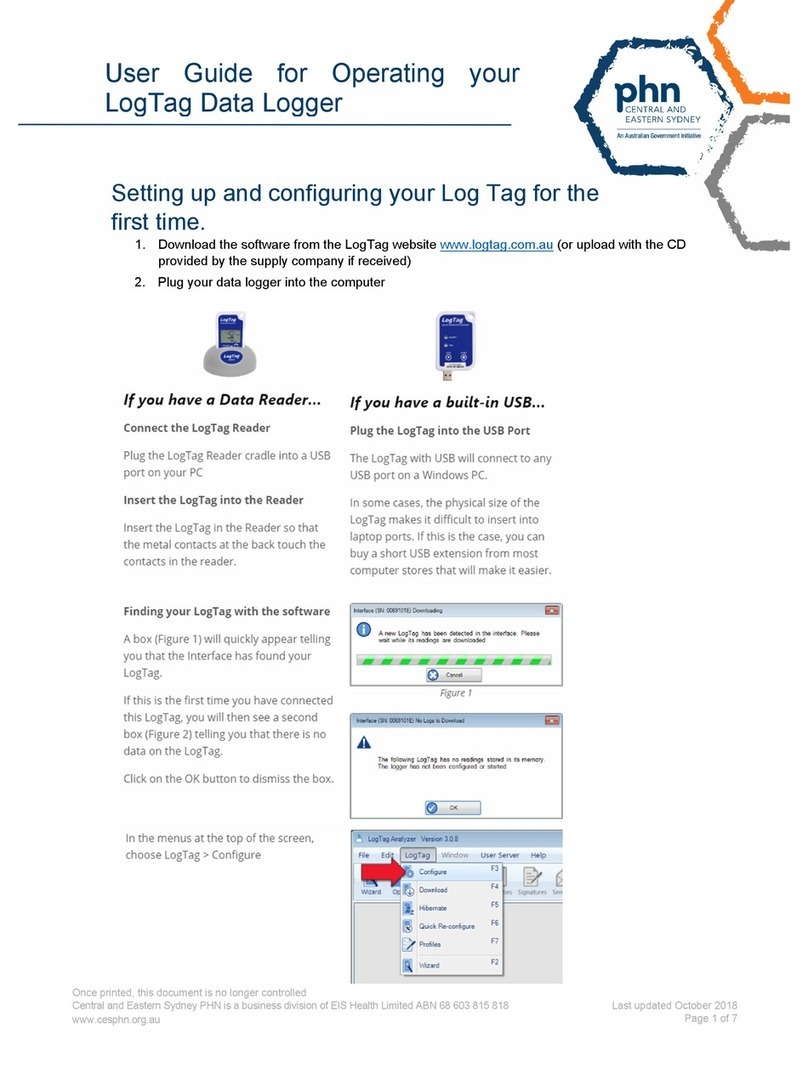
LogTag
LogTag TREX-8 User guide for operating

DREXAN
DREXAN HeatTracer Design/Install Guide
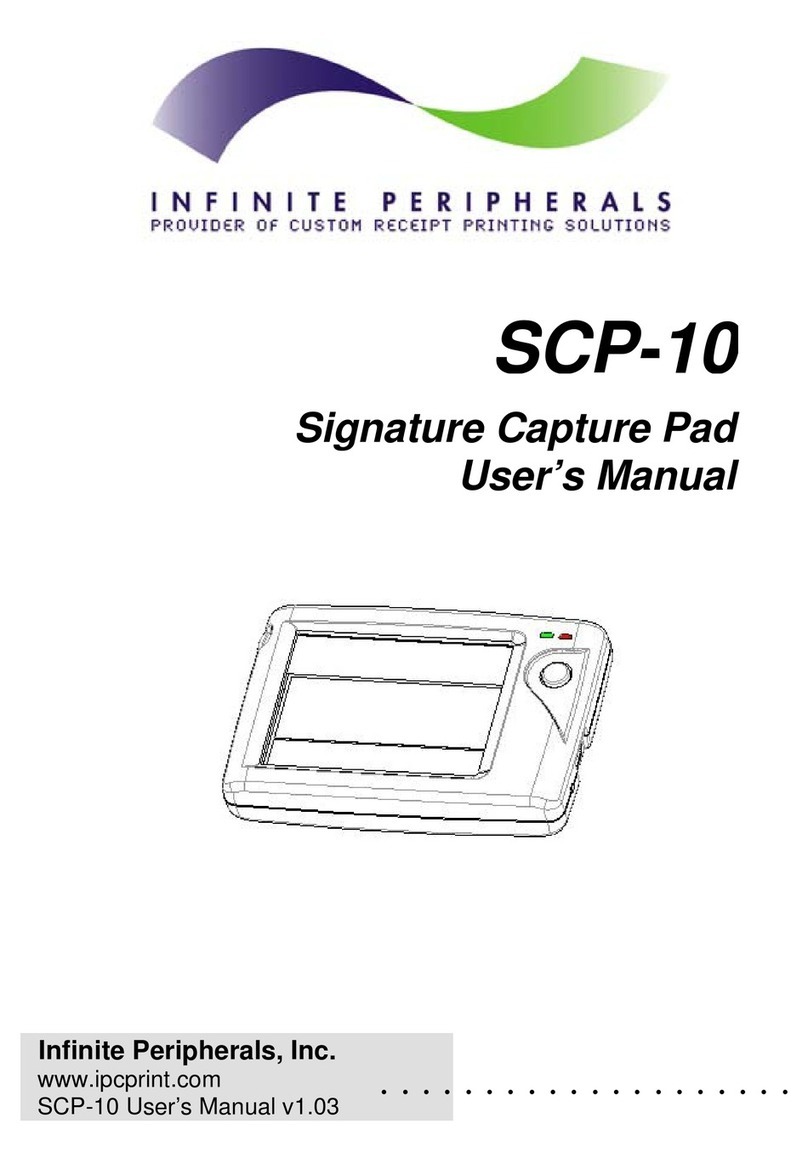
Infinite Peripherals
Infinite Peripherals SCP-10 user manual
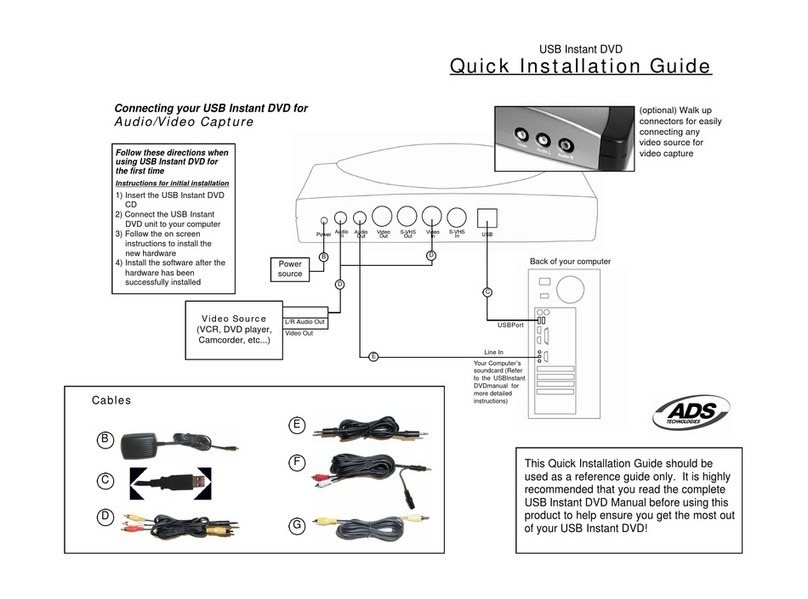
ADS Technologies
ADS Technologies Instant Video PCI Quick installation guide
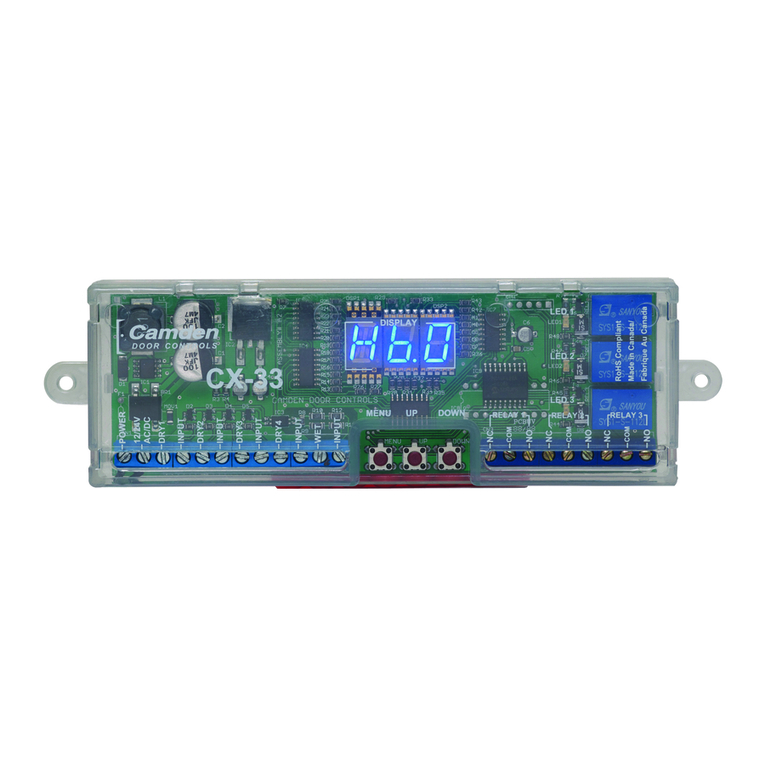
CAMDEN
CAMDEN CX-33 installation instructions

Tetra
Tetra Whisper 10i INSTRUCTIONS, SAFEGUARDS & WARRANTY


